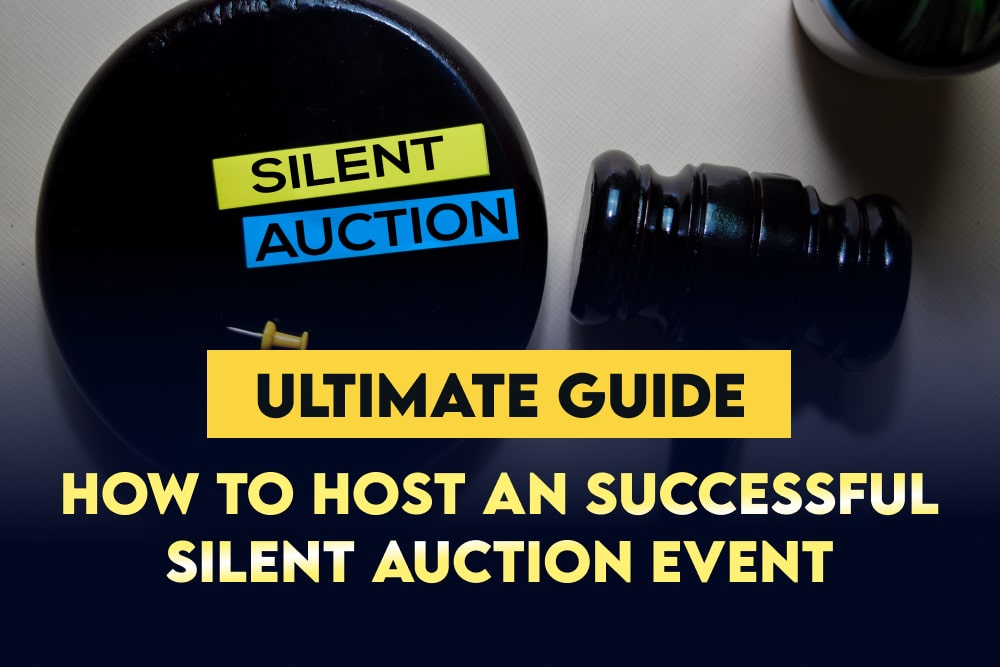

Head of HR at Rent For Event

Head of HR at Rent For Event
Silent auctions are a popular way to raise funds for various causes. Unlike traditional auctions, silent auctions are easier for everyone. You don’t have to attend an actual event and you can place a bid electronically or through writing. Many bidders and event organizers like you prefer this method since it’s centered on fundraising instead of competition.
But then again, the success of this event relies on your knowledge of how to host a silent auction. You must prepare and plan ahead to ensure a smooth-sailing and profitable auction, whatever cause you’re planning to support.
In this blog post, we will help you in hosting a silent auction. We will discuss the important steps that you need to take from planning to execution. Let’s dive in!

The steps on how to have a silent auction can be intimidating, especially for newbie planners. So to lighten the load, we condensed the major points into the steps below.
Before diving into the nitty-gritty details of planning your silent auction event, you should define your goals and objectives first. You need to consider the purpose of your event. It can be to raise funds for a specific charity, increase awareness, or boost the bond in your community.
Overall, setting clear goals will help you stay focused throughout the planning process. It will also put the next steps into perspective.
So how do you set goals for your silent auction? We suggest that you determine a fundraising target. This will be your benchmark to work towards and help you allocate resources wisely.
Aside from that, you can also list down other smaller objectives like attracting new donors, promoting community relationships, or improving your organization’s work.
Most of all, don’t forget to set your silent auction rules to keep everything in order.
For your silent auction to be successful, you need a dedicated team where you can delegate tasks for the event. This way, you won’t have to do almost everything on your own. Trust us, trying to do everything on your own will only compromise your event.
Instead, start forming a group of people with dedicated tasks. You can assign people to procure auction items and then other people to advertise the event. To keep things organized, you should list down tasks and then assign each individual who will be responsible for them.
You may need people for positions like event coordinator, marketing specialist, procurement lead, finance manager, and volunteer coordinator. Feel free to create more positions, depending on the needs of your event.
It’s not enough that you know how to do an auction; you should also have the right items for it. Attendees of your silent auction will surely look forward to the items up for bid, so it must be of good value.
If you don’t know what items to auction, you can partner with local artists and individuals for donors. Your choice of items should match the theme of your auction, the age group of your attendees, and their interests.
In silent auctions we’ve worked on, the most common items for grabs are paintings, ceramics, music records, sculptures, and memorabilia from famous people. There are literally a ton of possible items you can add to your auction.
Just because it’s silent doesn’t mean it has to be boring. You can make your silent auction more memorable by giving your bidders a more engaging experience.
If you have the budget, you can set up mobile bidding kiosks where guests can easily put their bids online. Aside from being convenient, this will also make it easier for you to identify who gets the winning bid for each item.
Also, you can offer a “buy it now” for some items. This means that your guests can buy the items right away without going through the bidding process. Also, this gives you a predictable profit for your event aside from the biddable items.
Whatever setup you prefer, make sure that everything is organized. You should group similar items together, so it will be easier for attendees to find things they are interested in. Also, you should label each item with relevant information and if you’re offering perishable items, there should be expiration dates included.
Even if you know the best way to run a silent auction, it will be in vain if people don’t know about the event. This is why you also need to market and promote your auction to attract attendees and donors.
You can do this via email, social media platforms, or press releases to news outlets. Also, don’t forget to tap into your local community networks to spread the word about your upcoming auction.
To make your promotions more effective, we suggest that you use eye-catching graphics and photos. For added appeal, you can also partner with local influencers to advertise your event.
Ideally, we recommend promoting your event at least a month before the actual date. This way, attendees can make time on their schedule and you can reach as many people as possible. As the auction day nears, you should share more sneak peeks of the items to keep the hype going.
If you like, you can also use ticketing services. This will help you generate profits before the event while also knowing the number of attendees you’d expect. Overall, it’s a good strategy of you have a limited-capacity venue and you want the auction to have an exclusive vibe.
Part of knowing how to do a silent auction is identifying the equipment you need for the event. This will ensure that your ideas will come to life and that all the attendees will be engaged in your program.
Some of the things you may need are sound equipment, LED screen rental, a stage, a projector, lights, and so on. If you’re not sure what gear you need, you can partner with a reliable AV company like Rent For Event.
We can advise you about the equipment you need and we can also deliver, install, operate, ad tear it down for you. This way, you don’t have anything to worry about during your silent auction event.
Aside from that, you should also coordinate with your venue before placing your rentals. Some venues may have specific requirements or limitations when it comes to third-party AV providers.
During your silent auction day, you should ensure that everything is organized. This includes the registration process, seating, program flow, bidder numbers, bidding instructions, and more. Also, the auction items must be displayed and easy to observe.
Moreover, there should be staff or volunteers to assist attendees in placing their bids. They should be trained to answer questions about the event as well as how to monitor the bids. Make sure that the entire process is clear to the attendees as much as it is with your team.
Also, make sure that you have a welcoming and friendly environment during the auction. This way, the attendees will be comfortable placing bids and spending money on your items.
We can advise you about the equipment you need and we can also deliver, install, operate, ad tear it down for you. This way, you don’t have anything to worry about during your silent auction event.
Aside from that, you should also coordinate with your venue before placing your rentals. Some venues may have specific requirements or limitations when it comes to third-party AV providers.
Once everyone has placed their bids, it’s time to announce who gets each item. Make sure that each item is awarded correctly to the winning bid.
Aside from that, you should also express your gratitude to all the donors and sponsors of your event. Also, don’t forget to thank your volunteers and the entire team for making the event possible. And if the items are too bulky to carry, you should also offer delivery arrangements.
Your job doesn’t end after the auction bidding. You also need to assess how well your event performed in terms of profits, attendee engagement, and overall impact.
Aside from accounting for your revenue, you should also gather feedback from the attendees. This will give you a firsthand assessment of your event’s success.
As much as you’d like positive feedback, make sure that you also handle negative ones with professionalism. Most of the time, negative feedback can help you host better events in the future.
Also, ask your team about the problems they encountered during the event. This will help you come up with a comprehensive review of your silent auction.
After all the metrics have been assessed, the last step you should do is send thank-you emails or notes to everyone involved. If have the extra budget, you can also send donors and sponsors a small token for being part of your event.
Hosting a successful silent auction requires proper planning and execution. Aside from procuring your auction items, you should also ensure that the process would be easy for your attendees.
Unlike traditional auctions, silent auctions can be a little tricky since they don’t involve verbal bids. For this, you can use electronic bidding systems to keep everything organized. It will also help you check who gets the winning bid fast and easily.
If you want to make your planning easier, don’t hesitate to partner with us at Rent For Event. Our team will provide all your needed AV equipment and event production services.